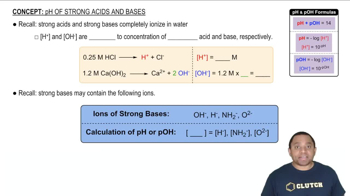Here are the essential concepts you must grasp in order to answer the question correctly.
Buffer Solutions
A buffer solution is a system that resists changes in pH upon the addition of small amounts of acid or base. It typically consists of a weak acid and its conjugate base or a weak base and its conjugate acid. In this case, the buffer is made from ammonia (NH3) and ammonium chloride (NH4Cl), which helps maintain a stable pH in the solution.
Recommended video:
Henderson-Hasselbalch Equation
The Henderson-Hasselbalch equation relates the pH of a buffer solution to the concentration of its acidic and basic components. It is expressed as pH = pKa + log([A-]/[HA]), where [A-] is the concentration of the base and [HA] is the concentration of the acid. This equation is essential for determining how to adjust the pH of the buffer by adding either an acid or a base.
Recommended video:
Henderson-Hasselbalch Equation
pH Adjustment with Strong Acids and Bases
When adjusting the pH of a buffer solution, adding a strong acid (like HCl) will increase the concentration of the conjugate acid, while adding a strong base (like NaOH) will increase the concentration of the conjugate base. To achieve a desired pH, one must calculate the necessary amounts of these reagents based on the buffer's current composition and the target pH, using the Henderson-Hasselbalch equation.
Recommended video:
pH of Strong Acids and Bases





